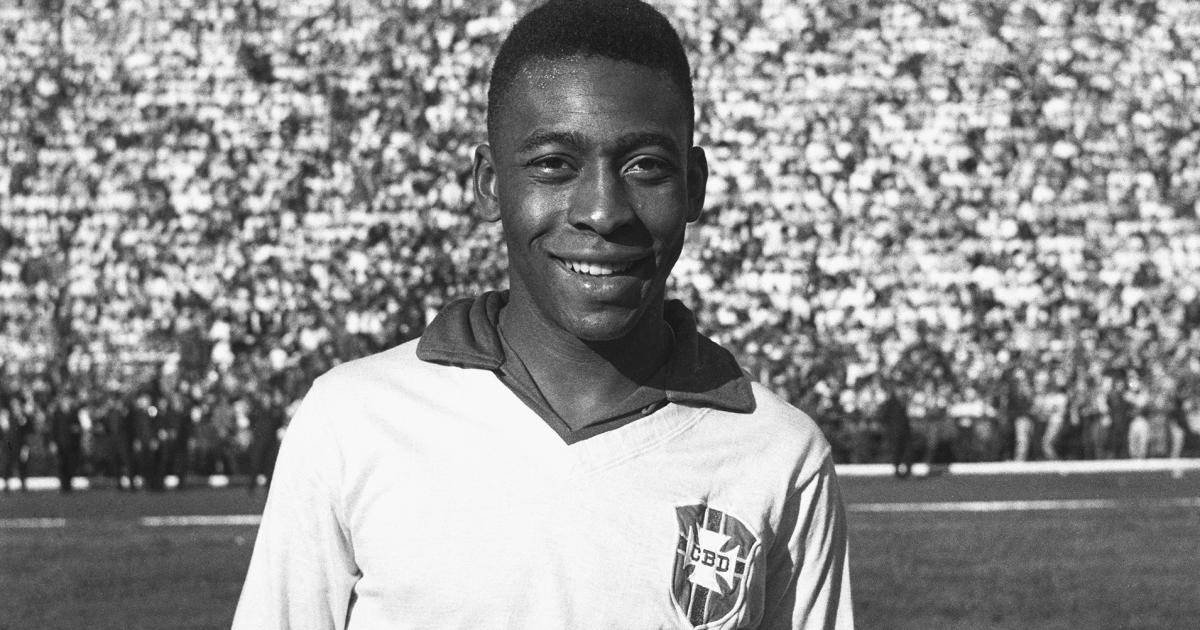
This story, by correspondent Paul Gardner, first appeared in the Oct. 29, 1977, issue of The Sporting News under the headline “Magic of Pele Ignites Soccer Boom in U.S.”
NEW YORK — Last August 14, Phil Woosnam, as usual, was in a hurry. Serving as commissioner of the North American Soccer League is that sort of a job these days, a job that had him leaping off a plane from Minneapolis and scampering across New York’s LaGuardia airport to climb aboard a waiting helicopter.
In a few moments, Woosnam was gazing down on Randall’s Island Stadium, dusty, decaying. deserted. There, across the roof of the hut-like press box, it said in large letters “Cosmos Soccer.”
Then Randall’s Island was gone as the copter flew over the concrete stalagmites of Manhattan and the Hudson River. Then, there in the distance, glowing like a beacon, were the floodlights of Giants Stadium, surrounded by a red and white spider’s web of slowly moving automobile lights.
AS THE COPTER dropped toward its landing place next to the stadium, Woosnam could look into the arena and see with marveling eyes the densely packed rows of spectators that encircled the 22 players moving on the field. He was looking down on the largest crowd ever to see a soccer game in North America. This, too, was Cosmos soccer.
In barely two minutes, Phil Woosnam had flown from the rags of Randall’s Island to the riches of a 77,691 SRO crowd at the Meadowlands.
It took the Cosmos a little longer to make that same journey — two years, in fact — but that was still an incredibly short period when one considers what had been accomplished: nothing less than the establishment of a new major league sport in America.
THE MAN who made it possible was, of course, Pele. Not alone — he would be the last to claim that. When he arrived here in 1975, American pro soccer was already a bubbling, lively mixture. The ingredients were there, but the hard crystals of a major league sport had yet to form.
Pele was the needed catalyst. As soon as he arrived, soccer became news. The media paid attention and the crowds began to turn out, slowly at first, but with gathering momentum until that evening in August when they packed Giants Stadium to watch the Cosmos play the Fort Lauderdale Strikers.
Pele had tears in his eyes that evening as he proclaimed that his mission was now fulfilled. He had done what Joe Namath had done for the Jets and the American Football League back in 1968, but he had done so much more. For Pele had struggled to give credibility not just to one team, nor even to a league, but rather to a whole new sport. He had brought soccer to Americans.
It is a measure of Pele’s uniqueness that in a world that contains literally thousands of pro soccer players, he was the only one who could have succeeded in this missionary role.
WHAT WAS it about Pele that made him unique?
He was born in the small Brazilian town of Tres Coracoes, in October 1940. Right from the start, soccer played an important part in his life. His father was a semipro player. A good player, in fact, but one whose career had been riddled with injuries.
In their splendid book “Pele’s New World,” authors Peter Bodo and Dave Hirshey have a telling quote from Pele: “As a young boy, I wanted to be my father. That is all.”
So, like his father, Pele fell in love with soccer. He played in the streets, played barefoot, played with a bundle of rags instead of a ball, played all day and played on into the moonlight.
The boys’ teams were soon too primitive to serve as vehicles for his precocious talent. He began playing alongside men three times his age. Inevitably, this spindly little dynamo was snapped up by a pro club, Santos.
WITHIN A YEAR, his 16-year-old body now sturdier, his legs looking like pure, bulging muscle, he was a regular starter on the Santos first team. Picked to play for the Brazilian national team in the 1958 World Cup finals in Sweden, he became an overnight sensation, the 17-year-old wonder child who led Brazil to the world championship.
And because that was the first time Brazil ever had won the title, Pele became an instant national hero. He was the savior, the one who had been sent to lead their national religion of soccer to the glories they had been awaiting for so long. And might it not be a minor miracle that their savior was little more than a boy?
With Pele, Brazil surged on, taking its second world title in 1962 and a third in 1970. No other nation had ever won more than twice before. His club team, Santos, captured the world title for clubs in 1962 and 1963, another title that no Brazilian club ever had been able to win before.
THE FIGURE of Pele dominated Brazilian soccer. In an age when fast, economical air travel was at last a reality, he became an international attraction. Everyone, everywhere, wanted to see Pele and his club Santos.
The team traveled all over the globe, playing as many as 90 games a year. Santos could charge up to $40,000 for an exhibition game. If Pele was unable to play, the price went down dramatically. Not that it mattered, for the usual result of Pele’s absence was that the game was called off.
The fans were Japanese, they were American or Poles or Egyptians or Colombians. It made no difference. Pele’s message was universal. They all stood and cheered for soccer as they never before had seen it played.
They watched a young man who came as close to being the complete soccer player as anyone ever has come. One is tempted to say “as anyone ever will come.”
PELE SEEMED to be bursting with skills. They flowed from him in an endless, astonishing abundance. No wonder many felt that he could not last, that he must be yet another youthful phenomenon, doomed to be burned out within a few seasons.
But Pele went majestically on, year after year, promiscuously displaying his talents. Far from fading out, he shone brighter and brighter.
No game in which Pele played was an ordinary game. He transformed it by his mere presence, he dramatized it with the expectation of unusual, the promise of the improbable, the possibility of the downright impossible.
His dribbling was sheer delight to watch, impudent, inventive and apparently invincible. His shooting, with left or right foot, was tremendous, whether the ball was hit true or whether it was spun into an insidious curve. His jumping and heading bordered on the unbelievable for a man of only 5-8.
YET THERE HE was, soaring above taller opponents, flexing his body, then crashing his forehead violently into the ball. Even his trapping, not usually considered a spectacular part of the sport, drew gasps of admiration. The ball, so bouncy, so uncontrollable for everyone else, seemed to turn to a lump of docile cotton wool when Pele took control of it.
All of this brilliance was gathered together within the framework of a masterly vision of the game — a vision that took in everything that was happening on the soccer field, that always seemed to be at least two moves ahead of everyone else, that was, on many occasions, simply too good, too advanced, for his merely mortal teammates.
What made Pele all the more superhuman was that he had needed no time to mature. He came into world-class soccer audaciously early, yet all the skills were there from the beginning.
ONE THING that greatly helped Pele’s rise to fame was that he was an attacking player. There was an end product to those skills, not something nebulous like a freeform dribble, but something measurable and finite: goals.
Pele scored them by the hatful, scored them in a hundred different ways from a simple tap of his foot to a diving header to a slashing overhead bicycle kick.
Even after the word got around — as it did very quickly — and Pele was ever more a marked man, covered by two or even three opponents whenever he took the field, he was scoring, apparently delighting in the increasing difficulty of his task. No opponent, no team, ever succeeded in totally neutralizing Pele.
Some spoke of Pele as a goalscoring machine, but that was an ignorant label. There was nothing mechanical about Pele, the prince of invention, the very king of individuality on the soccer field.
HE SPARKLED and dazzled with all the brilliance of a massive diamond and he had, too, another diamond-like quality — a hardness that gave him a relatively injury-free career, a hardness that, ever so rarely, he needed to sustain him against ruthless opponents.
There is a photograph, taken in 1964, of an Argentine player named Mesiano, his face covered in bandages. During a Brazil vs. Argentina game, Pele — infuriated by Mesiano’s tactics — had butted him in the face, breaking his nose. Pele’s patience was not limitless, but this was an uncharacteristic aggression.
More typical was the sort of behavior that the former Cosmos Coach Gordon Bradley remembered.
“I’ve seen him do some silly things on the field, sure, but at the end of the game, he always makes it up,” Bradley said. “Now that’s the worst time to talk to opponents, especially if you’re on the losing team. But I’ve never seen him walk off ignoring them, with his head down.”
DIGNITY, that was the priceless quality that Pele added to his soccer genius. An irresistible integrity, an undeniable sincerity, a melting humanity. They are qualities that are not seen too often these days around the pro sports scene in this country, and they appealed, quickly and deeply, to Americans.
They saw this incredible man, the most popular and the most loved athlete in the world, and they saw that — despite all the adulation and the pressures — he had survived intact, he was still a humble man. They saw that and they loved him for it.
Everywhere Pele went, people wanted his autograph. All sorts of people, young and old, famous and obscure, and always Pele obliged with the four magic letters, “Pele,” carefully written, accompanied by a smile.
Especially when there were children around, Pele seemed reluctant to stop signing.
“THERE WERE many occasions when we could have made an easy exit from a stadium,” recalled Bradley, “but Pele delayed us. He wanted to sign that last autograph. He could always see the little boy who was being squeezed out, the kid who was furthest away, and he wanted to sign for him.”
What was this — charm, innocence, genuine love or was it clever public relations? Certainly as his career progressed, Pele came to learn the publicity value of greeting crowds, of shaking hands with celebrities or signing autographs. But only someone who believed in what he was doing could have done it so wholeheartedly, so sincerely, for so long.
The sincerity was there, too, in Pele’e approach to religion.
While he frequently thanked God for giving him “the perfect body for soccer,” he believed that religion was a private matter. It was not something to be cheapened by public displays of devotion. There were no dramatic locker room prayers, no attempts to enlist the Almighty into taking sides in championship races.
“I HAVE NEVER asked God to help me in my career, whether to win titles or important games,” Pele once said. “God has nothing to do with soccer fields. He has more important things to think about.”
This combination of dignity, sincerity and transcendent soccer skills made Pele a figure that even the greatest of his colleagues looked up to.
What happened in Belgium in early 1975 underlined the depth of that respect. A farewell game was being organized for Belgium’s greatest player, Paul van Himst. Invitations had been sent to top soccer stars throughout the world, asking them if they would play on an all-star team in the game.
A week before the game, the situation was bleak, the acceptances had been few. Then it was announced that Pele had agreed to play. And suddenly everyone wanted to play in van Himst’s farewell game.
THE OPPORTUNITY of playing a season on the same team as Pele also was something that carried a lot of weight in the decision of Franz Beckenbauer — arguably the greatest player in the world today — to join the Cosmos.
When Pele came to the United States, he was past his prime. There is no point in pretending otherwise. But such had been the level of his achievements that even playing below his best, he was still better than most, and certainly superior to any players that the North American Soccer League then had to offer.
During his three seasons here, we have had to be content with only occasional flashes of his unmatchable artistry. He had lost that fraction of a second of mental and physical sharpness that is essential in soccer and that was so vital to his exquisitely timed game. But he was still capable of doing things that no one else on the field could hope to do, could even imagine. And now, because they came less frequently, these moments seemed to blaze even more brightly.
THERE WAS one of those moments during Pele’s final game. He had played the first half for the Cosmos, against his old team Santos, and had scored a wonderful goal on a 30-yard free kick.
In the second half, he changed shirts and played for Santos. With the Cosmos leading, 2-1, what better way for Pele to go out than to score the tying goal for Santos?
He had his chance. The ball was centered low across the Cosmos goalmouth … and there was Pele, perfectly positioned, racing in to meet it. As everyone tensed for the shot, for the goal, Pele stepped over the ball, letting it run through to a better-placed Santos teammate (who, alas, muffed his shot). The chance was gone. Pele’s instinct for the unexpected in soccer, his unselfishness, had deprived him of that final goal, one he would dearly have loved to score.
HALF AN HOUR later, he was being chaired off the field by his Cosmos teammates, his bare back glistening in the pouring rain, the back on which American pro soccer had ridden to success.
Pele has gone from the soccer fields of the world, yes, but he never will be gone from the world of soccer. He did what all great artists do, he did things with a soccer ball that no one ever had seen be fore and he did them with a style that was completely his own. He was an original, inimitable. He leaves a hole in the mosaic of soccer that no player ever will fill: only time will blur the edges … ever so slowly.





